Apodizing Reflective ND Filters
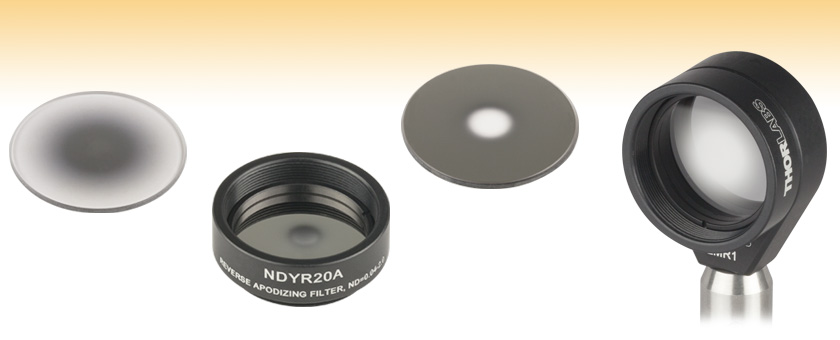
- Apodizing and Reverse Apodizing Filters
- Change Intensity Profile Between Gaussian and Flat
- Ø25 mm Filters Available Mounted or Unmounted
NDY10B
Apodizing Filter
NDYR20A
Reverse Apodizing Filter
NDYR20B
Reverse Apodizing Filter
NDY20A
Apodizing Filter
Mounted on an
LMR1 Fixed
Lens Mount

Please Wait
| General Specificationsa | |
|---|---|
| Diameter (Unmounted) | 25.0 +0.0/-0.25 mm |
| Clear Aperture | >90% Unmounted Diameter |
| Surface Flatness | <5λ @ 632.8 nm |
| Surface Quality | 60-40 Scratch-Dig |
Features
- Change Beam's Intensity Profile
- Gaussian to Near-Flat Top (Apodizing)
- Flat to Near-Gaussian (Reverse Apodizing)
- Continuously Variable Attenuation from 0.04 - 1 or 0.04 - 2 OD
- Usable Range: 350 - 1100 nm
- Available Mounted or Unmounted
- Unmounted Filters: 25 mm (0.98") Outer Diameter
- Mounted Filters: Housed in SM1-Threaded (1.035"-40) Lens Cell that is Engraved with the Part Number and Optical Density Range
Thorlabs’ Apodizing and Reverse Apodizing Filters are designed to augment the intensity profile of a beam to provide smooth intensity profiles and even illumination. An apodizing filter reshapes a Gaussian profile into a near-flat-top, constant-intensity beam, while a reverse apodizing filter reshapes a flat-top profile into a near-Gaussian intensity distribution. These filters are ideal for even illumination and condensing systems as well as improving the dynamic range of imaging systems. For instance, apodizing filters are employed in astronomy to differentiate low-intensity sources from brighter, neighboring sources. This technique even allows planets close to a bright star to be imaged.
Both the apodizing and reverse apodizing filters are coated with a reflective metallic layer that has a near-Gaussian density distribution. For the apodizing filters, this distribution starts with a coated center and continuously falls off to the uncoated edge. For the reverse apodizing filters, the distribution starts with an uncoated center and continuously rises to the dark edge (see Graphs tab for more details). To prevent oxidation, Thorlabs recommends using these filters at temperatures below 100 °C.
These Ø25 mm filters are available either unmounted or integrated into a mount featuring internal SM1 threads (1.035"-40) on one side and external SM1 threads on the other. If desired, a mounted filter can be removed from its housing by unscrewing the retaining ring that secures the filter to the mount. Thorlabs offers a range of spanner wrenches that are an ideal match to these retaining rings.
| General Specifications | |||
|---|---|---|---|
| Diameter | 25.0 +0.0/-0.25 mm | ||
| Clear Aperture | >90% of Outer Diameter | ||
| Substrate | N-BK7a | ||
| Substrate Thickness | 1.0 ± 0.25 mm | ||
| Surface Flatness (Over Clear Aperture) | <5λ at 632.8 nm | ||
| Surface Quality | 60-40 Scratch-Dig | ||
| Parallelism | <3 arcmin | ||
| Item # | NDY10A NDY10B |
NDY20A NDY20B |
NDYR10A NDYR10B |
NDYR20A NDYR20B |
|---|---|---|---|---|
| Optical Density @ Edge | 0.04 OD | 0.04 OD | 1.0 OD | 2.0 OD |
| Transmission @ Edge | 91.2% | 91.2% | 10% | 1% |
| Optical Density @ Center | 1.0 OD | 2.0 OD | 0.04 OD | 0.04 OD |
| Transmission @ Center | 10% | 1% | 91.2% | 91.2% |
Optical Density
Optical density (OD) indicates the attenuation factor provided by an optical filter, i.e. how much it reduces the optical power of an incident beam. OD is related to the transmission, T, by the equation

where T is a value between 0 and 1. Choosing an ND filter with a higher optical density will translate to lower transmission and greater reflection of the incident light. For higher transmission and less reflection, a lower optical density would be appropriate. As an example, if a filter with an OD of 2 results in a transmission value of 0.01, this means the filter attenuates the beam to 1% of the incident power.
Apodizing Filters
Reverse Apodizing Filters
| Posted Comments: | |
user
(posted 2022-05-23 11:20:49.69) When using these apodizing filters, what Gaussian beam diameters are required get to as close to flattop as possible? jgreschler
(posted 2022-05-24 10:21:36.0) Thank you for reaching out to Thorlabs. For best results the entire clear aperture should be filled. Maximilian Ulbrich
(posted 2021-03-25 14:10:41.833) Dear Thorlabs Team,
I am interested in a reverse apodizing filter that shapes the center of my Gaussian beam to a flat top while preserving the maximum amount of power in the flat part. This is particularly useful in single molecule microscopy experiments, where the field of view should be illuminated uniformly and a high power is required.
However, when using the NDY10B part, an unnecessary amount of power is lost. A simple calculation shows that independent of the laser beam diameter, the center of the filter should have an optical density of 0.434, and drop to 0 towards the edge. This means the center transmits a fraction of 1/e = 36.8% of the light compared to the edge.
The total fraction of the laser power carried in the flat part of the beam after the filter is then also at 36.8%.
Maybe you could consider a part like this for the future!
Thanks,
Max YLohia
(posted 2021-04-08 10:38:55.0) Hello Max, thank you for your feedback. We will consider offering such an item in the future. user
(posted 2020-05-13 04:36:58.923) I'm looking for a reverse apodizing filter for a high power laser beam. The dimension of the optic should be 4" diameter and the central aperture from 3 to 5 cm in diameter. The transition of the radial reflectivity profile should follow roughly a super-Gaussian curve of power 8. Do you have the possibility to manufacture such a custom optic? YLohia
(posted 2020-05-13 09:24:43.0) Thank you for contacting Thorlabs. Custom optics can be requested by emailing techsupport@thorlabs.com. We will reach out to you to discuss the feasibility of offering this. ypk
(posted 2018-10-22 02:11:30.023) Will the product work for 1 mm diameter He-Ne laser beam. If not, can you please give a customary quote for the same. YLohia
(posted 2018-10-22 09:58:39.0) Hello, thank you for contacting Thorlabs. Unfortunately, this filter is not suitable for a 1mm diameter beam. I will contact you directly to discuss the possibility of offering a custom filter. kirk.mckenzie
(posted 2015-10-17 19:13:34.97) This is a great product. I would like this to be made for a 1mm beam (that is 10x smaller than the current version).
I would be happy to by such a product as a custom job. If possible please quote me on 10 of modified version of ND20A.
Thank you!
Kirk besembeson
(posted 2015-10-27 05:44:15.0) Response from Bweh at Thorlabs USA: We will contact you via email for a custom quotation if possible since we will need new mask designs to get the desired profile for such a beam diameter. |

- Ø25 mm, Unmounted Apodizing Filters for 350 - 1100 nm
- 0.04 to 1 OD or 0.04 to 2 OD Radially Variable Coating (Edge to Center)
- Produces a Near-Flat Intensity Profile from a Gaussian Input
Thorlabs’ Ø25 mm apodizing filters produce a near-flat-top intensity profile from a Gaussian input. These unmounted filters are compatible with any Ø1" optical mount capable of accepting a 1.0 mm thick optic (such as the LMR1, SCL03, or CP33). To prevent oxidation, Thorlabs recommends using these filters at temperatures below 100 °C.

- Ø25 mm, Unmounted Reverse Apodizing Filters for 350 - 1100 nm
- 0.04 to 1 OD or 0.04 to 2 OD Radially Variable Coating (Center to Edge)
- Produces a Near-Gaussian Intensity Profile from a Flat-Top Input
Thorlabs’ Ø25 mm apodizing filters produce a near-Gaussian profile from a constant, flat-top input. These unmounted filters are compatible with any Ø1" optical mount capable of accepting a 1.0 mm thick optic (such as the LMR1, SCL03, or CP33). To prevent oxidation, Thorlabs recommends using these filters at temperatures below 100 °C.

- Ø25 mm, Mounted Apodizing Filters for 350 - 1100 nm
- 0.04 to 1 OD or 0.04 to 2 OD Radially Variable Coating (Edge to Center)
- Produces a Near-Flat Intensity Profile from a Gaussian Input
Thorlabs’ Ø25 mm apodizing filters produce a near-flat-top intensity profile from a Gaussian input. These mounted filters featuring internal and external SM1 (1.035"-40) threading, making them compatible with any SM1-threaded mount (such as the LMR1 or TRF90). To prevent oxidation, Thorlabs recommends using these filters at temperatures below 100 °C.

- Ø25 mm, Mounted Apodizing Filters for 350 - 1100 nm
- 0.04 to 1 OD or 0.04 to 2 OD Radially Variable Coating (Center to Edge)
- Produces a Near-Gaussian Intensity Profile from a Flat-Top Input
Thorlabs’ Ø25 mm reverse apodizing filters produce a near-Gaussian profile from a constant, flat-top input. These mounted filters featuring internal and external SM1 (1.035"-40) threading, making them compatible with any SM1-threaded mount (such as the LMR1 or TRF90). To prevent oxidation, Thorlabs recommends using these filters at temperatures below 100 °C.
 Products Home
Products Home












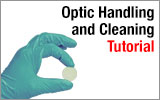

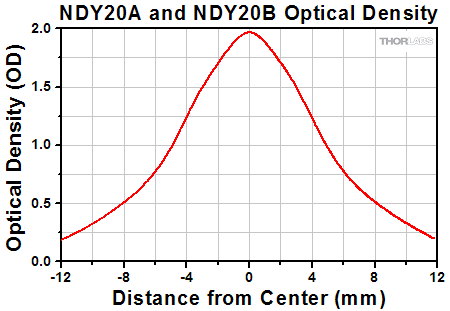
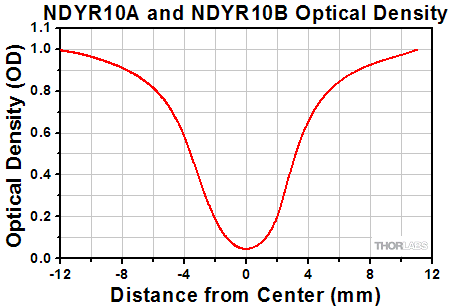
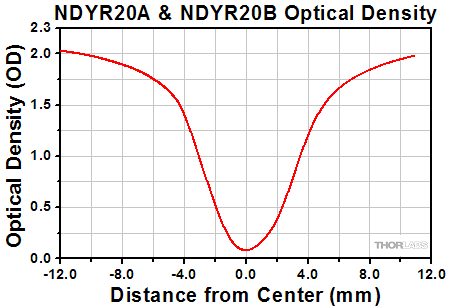
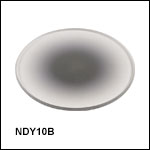
 Zoom
Zoom
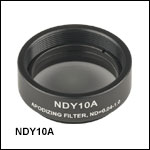
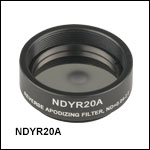
 Apodizing Reflective ND Filters
Apodizing Reflective ND Filters